
A shipwreck is the wreckage of a ship that is located either beached on land or sunken to the bottom of a body of water. Shipwrecking may be intentional or unintentional. There were approximately three million shipwrecks worldwide as of January 1999, according to Angela Croome, a science writer and author who specialized in the history of underwater archaeology.

The Bass Strait Triangle is the waters that separate the states of Victoria and Tasmania, including Bass Strait, in south-eastern Australia. The term Bass Strait Triangle appears to have been first used following the disappearance of Frederick Valentich in 1978 although the region had a bad reputation long before that.

No. 9 Squadron is a unit of the Royal Australian Air Force (RAAF). The squadron was formed in early 1939 and saw active service in World War II as a fleet co-operation unit providing aircrews for seaplanes operating off Royal Australian Navy cruisers. It was disbanded in late 1944, but was re-raised in 1962 and later became an Army co-operation unit, flying helicopters in support of Australian troops during the Vietnam War. The squadron was disbanded in 1989 when the RAAF transferred its battlefield helicopters to the Australian Army's aviation regiments. It was re-raised in June 2023 to operate Northrop Grumman MQ-4C Tritons.

Double Island Point is a coastal headland in Queensland, Australia. It is the next headland north of Noosa and is within the Cooloola section of the Great Sandy National Park, at the southern end of Wide Bay. It is approximately 12km south along the beach from the tourist township of Rainbow Beach.
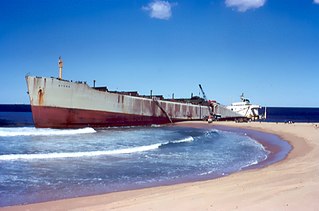
MV Sygna was a Norwegian bulk carrier built by Austin & Pickersgill for J. Ludwig Mowinckels Rederi in 1967. It ran aground on Stockton Beach in Australia during a major storm in 1974. After its bow section was refloated, its stern remained beached and became an icon and landmark for the local area, until the visible remains of the wreck collapsed into the sea in 2016.
Benjamin Cropp AM is an Australian documentary filmmaker, conservationist and a former six-time Open Australian spearfishing champion. Formerly a shark hunter, Cropp retired from that trade in 1962 to pursue oceanic documentary filmmaking and conservation efforts. One of his efforts for The Disney Channel, The Young Adventurers, was nominated for an Emmy award.
The Wreck is a surf spot located at Byron Bay, New South Wales, Australia. It is approximately 30 metres (98 ft) off the shore of Belongil Beach, and approximately 60 metres (200 ft) from the Main Beach Car Park.
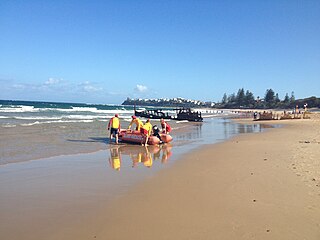
Dicky Beach is both a beach and coastal suburb of Caloundra in the Sunshine Coast Region, Queensland, Australia. In the 2016 census, Dicky Beach had a population of 1,895 people.

Teewah Beach is a beach that extends from Double Island Point in Cooloola, Gympie Region through Noosa North Shore in the Shire of Noosa to the Noosa River in Queensland, Australia. It is part of the Great Sandy National Park. The beach extends from approximately 25°56'11"S, 153°11'18"E to 26°22'44"S, 153°04'38"E, a distance of about 51 kilometres.
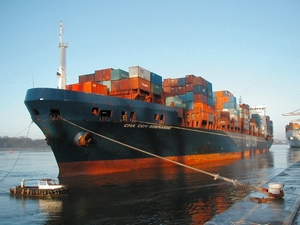
MSC Napoli was a United Kingdom-flagged container ship that developed a hull breach due to rough seas and slamming in the English Channel on 18 January 2007. She was deliberately run aground at Lyme Bay to avoid an environmental disaster and broken up by salvors.

SS Daniel J. Morrell was a 603-foot (184 m) Great Lakes freighter that broke up in a strong storm on Lake Huron on 29 November 1966, taking with her 28 of her 29 crewmen. The freighter was used to carry bulk cargoes such as iron ore but was running with only ballast when the 60-year-old ship sank. When built in 1906, she was the "Queen of the Lakes", being the longest ship then in service on the Great Lakes.
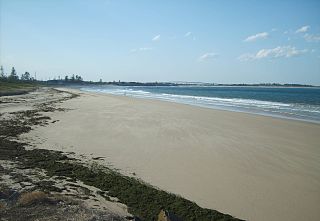
Stockton Beach is located north of the Hunter River in New South Wales, Australia. It is 32 km (20 mi) long and stretches from Stockton, to Anna Bay. Over many years Stockton Beach has been the site of numerous shipwrecks and aircraft crashes. In World War II it was fortified against a possible attack by Imperial Japanese forces. During that time it served as a bombing and gunnery range as well as a dumping area for unused bombs by aircraft returning from training sorties. The length of the beach, its generally hard surface and numerous items of interest along the beach make it popular with four-wheel drive (4WD) enthusiasts. Four-wheel drive vehicles are permitted to drive on Stockton Beach provided the vehicles are in possession of valid permits. The beach is also popular with fishermen and several different varieties of fish may be caught.

A surf break is a permanent obstruction such as a coral reef, rock, shoal, or headland that causes a wave to break, forming a barreling wave or other wave that can be surfed, before it eventually collapses. The topography of the seabed determines the shape of the wave and type of break. Since shoals can change size and location, affecting the break, it takes commitment and skill to find good breaks. Some surf breaks are quite dangerous, since the surfer can collide with a reef or rocks below the water.

Severe Tropical Cyclone Ului was one of the fastest intensifying tropical cyclones on record, strengthening from a tropical storm to a Category 5 equivalent cyclone within a 30-hour span in March 2010. Throughout Queensland, Australia, infrastructural damage from the storm amounted to A$20 million (US$18 million) and agricultural losses reached A$60 million (US$54 million).
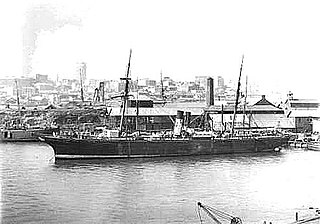
City of Adelaide was an iron-hulled ship that was launched in Scotland in 1863, spent a long career in Australian passenger and cargo service, and sank off the coast of Queensland in 1916. She served with several Australian shipowners, including the Australasian Steam Navigation Company, Australasian United Steam Navigation Company and Howard Smith Company.

The RMS Mülheim was a German cargo ship that was built in Romania and launched in May 1999. It was wrecked on 22 March 2003 at Land's End, United Kingdom.

Shipwrecking is an event that causes a shipwreck, such as a ship striking something that causes the ship to sink; the stranding of a ship on rocks, land or shoal; poor maintenance, resulting in a lack of seaworthiness; or the destruction of a ship either intentionally or by violent weather.

The MV Seli 1 was a Turkish bulk carrier, operated by TEB Maritime of Istanbul, that was en route to Gibraltar when it was driven aground off Bloubergstrand near Table Bay, South Africa by strong westerly winds shortly after midnight on 8 September 2009, having reported engine failure and a snapped anchor chain.

The Australian Defence Force has operated Boeing CH-47 Chinook heavy-lift helicopters for most of the period since 1974. Thirty four of the type have entered Australian service, comprising twelve CH-47C variants, eight CH-47Ds and fourteen CH-47Fs. The helicopters have been operated by both the Royal Australian Air Force (RAAF) and Australian Army.





















